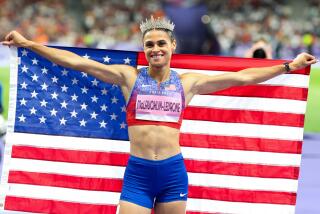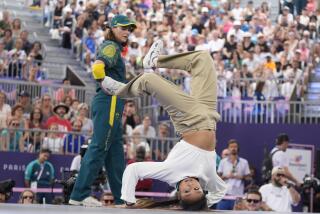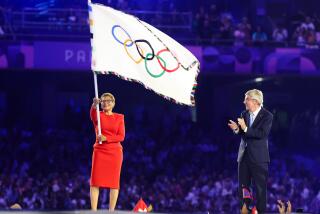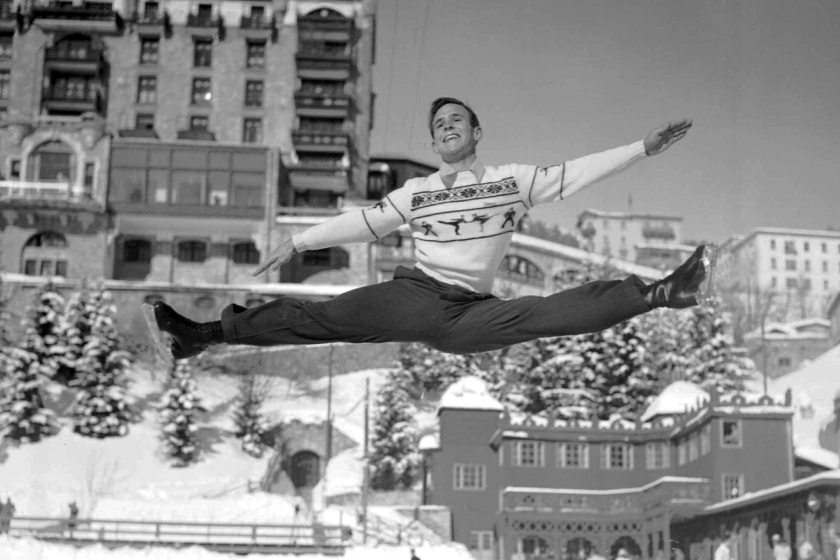Greene Brings Home Gold : He runs down Britain’s Chambers to anchor U.S. 400 relay victory and stand atop podium for third time in eight days.
- Share via
SEVILLE, Spain — Before boarding the Iberia Airlines flight from Madrid to Seville, Inger Miller made sure she grabbed the boarding passes for the HSI club that trains in Westwood. She ended up with an aisle seat. Maurice Greene had to sit in the middle.
That was the last time anyone has been too quick for Greene.
From the moment he arrived in the airport terminal here, where he chased down a would-be robber trying to steal a teammate’s luggage, to the final day of track and field’s World Championships on Sunday, when he chased down Great Britain’s Dwain Chambers in anchoring the U.S. 400-meter relay team to a gold medal, Greene has been at least a step faster than everyone else.
The relay gold was his third in eight days after victories in the 100 and 200 meters, putting him in Carl Lewis and Michael Johnson territory. They’re the only other men to have won three gold medals in the same World Championships.
Ato Boldon, who trains with Greene and is the only man to beat him at either the 100 or 200 this summer, says no sprinter has ever had a better year.
Maybe. Maybe not. Jesse Owens once set four world records in one day in 1935. Carl Lewis had some very good years. But it is at least arguable.
John Smith, who coaches the HSI athletes, said Greene told him when he arrived in Westwood two years ago that he wanted someday to have his name mentioned in the same sentence with Owens and Lewis.
“He said his goal was to be the best there ever was,” Smith said. “He said he wanted to carry track and field on his back and bring the sport back to America.”
It’s an honorable goal, but he doesn’t have to do it alone. Johnson proved here with his world record in the 400 and his anchor leg on the winning 1,600 relay team that he still has strong shoulders. They can share the load.
That might not thrill Greene, who has hinted that Johnson is avoiding him in the 200. It might have appeared that way on one occasion this summer, Johnson has since offered a credible explanation, and Greene has to join the rest of the track and field world in giving him his respect. Doesn’t he?
*
The final day of a major track and field meet is usually entertaining because of the relays, but there were also some compelling individual finals Sunday.
Wilson Kipketer, a native Kenyan who runs for Denmark, won the 800. That was expected. It was not expected that he would have to lean at the finish line to beat South Africa’s Hezekiel Sepeng. So unaccustomed is Kipketer to leaning that he fell awkwardly, looking a little bit like an American League pitcher sliding into second base.
Russia’s Svetlana Masterkova won the 1,500, outmaneuvering second-place Regina Jacobs of the United States going into the final turn.
The other American in the race, Marla Runyan, received more attention going into the final than the medal favorites because she is legally blind. A two-time gold medalist in the Paralympics, she was competing against sighted athletes for the first time in a major international event.
She finished 11th, blaming her inexperience in running rounds. The women had to run semifinals Friday night.
She said she will try the 800 or the 1,500 next summer, an Olympic year, and then seek a new challenge.
“I may in the future explore the steeplechase, but don’t tell anybody,” she said. “My coach doesn’t know yet.”
OK. It’s our secret.
*
A few words about Seville:
The recent death of former Montreal Mayor Jean Drapeau, the man who said the Olympics could no more produce a deficit than a man could have a baby, didn’t receive much attention here. Considering Quebecois taxpayers are still paying for the 1976 Summer Olympics, his gravestone should read: “Be careful what you ask for. . . “
Los Angeles learned from Montreal and voted in 1978 to spend no public money on the 1984 Games. Seville either learned nothing or has forgotten and, if successful, its bid for the 2008 Summer Olympics would seemingly require public expenditures that might bankrupt the Andalusian region through the next millennium.
A city of 700,000, Seville has an undersized airport, nowhere near enough hotels and the sports facilities to accommodate only a few events. It does have a grand new 60,000-seat stadium, Estadio Olimpico, that was built for this meet, the hoped-for Olympics and not much else. Neither of the city’s first division soccer teams will play there. How do you say “white elephant” in Spanish?
Seville, however, was a fine place for a track meet, although August was the wrong month.
Primo Nebiolo, the International Amateur Athletic Federation president, fooled no one when he asked the mayor to turn off the digital temperature signs. The exact temperature is merely a detail. As Robin Williams, forecasting the weather in “Good Morning, Vietnam,” says, “Today, hot; tomorrow, hot; Tuesday, hot.”
The local newspapers gave the organizers a hard time when a fake Giraldilla, the mascot, sneaked onto the field for the opening ceremony bearing a sign supporting Basque separatism.
“The World Championships of Incompetence,” El Mundo editorialized.
But, for everyone else, that was a case of no harm, no foul. It’s a local issue.
If you’re looking for a tourist destination in a month other than August, I highly recommend Seville. James Michener once said, “Seville does not have ambience; it is ambience.” That has changed little despite the modern touches.
A lasting image of Seville for me will be a photograph I saw on a restaurant wall of a matador with a cell phone.
I was amused by it, even while recognizing it’s probably not the picture Hemingway had in mind when he wrote “Death in the Afternoon.”
Randy Harvey can be reached at his e-mail address: [email protected]
More to Read
Go beyond the scoreboard
Get the latest on L.A.'s teams in the daily Sports Report newsletter.
You may occasionally receive promotional content from the Los Angeles Times.






